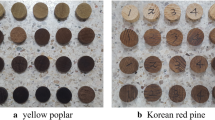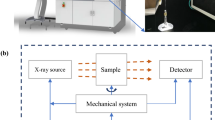Abstract
This paper presents a method for identifying wood morphological parameters from gas apparent permeability measurements. The apparent permeability at a given mean pressure is typically determined from the pressure relaxation kinetics when the gas permeates through the wood sample between two compartments which have different initial pressures. Using the proposed set-up, apparent permeability values ranging from 10−10 to 10−18 m2 can be measured with a mean gas pressure varying from 2 bar down to 35 mbar. Morphological and topological parameters are then identified from the variations in apparent permeability as a function of the mean gas pressure using a pore network model. The network consists of elements such as pipes or orifices connected in series or in parallel. The rarefied gas flow is described in each element by an appropriate model, and the unknowns are determined by an inverse method. This approach was first applied to track-etched polycarbonate membranes for validation purposes. The calculated pore radius and pore density values were compared to observations by environmental scanning electron microscopy. Softwood specimens were then investigated. The mean radius of the pores controlling permeability in the longitudinal and tangential directions was determined and found to be in good agreement with literature data.










Similar content being viewed by others
References
Adzumi H (1937) On the flow of gases through a porous wall. Bull Chem Soc Jpn 12:304–312
Agoua E, Perré P (2010) Mass transfer in wood: identification of structural parameters from diffusivity and permeability measurements. J Porous Media 13:1017–1024
Agrawal A, Prabhu SV (2008) Survey on measurement of tangential momentum accommodation coefficient. J Vac Sci Technol, A 26:634–645
Ai W, Duval H, Pierre F, Perré P (2017) A novel device to measure gaseous permeability over a wide range of pressure: characterization of slip flow for various wood species and wood-based materials. Holzforschung 71:147–162
Almeida G, Leclerc S, Perre P (2008) NMR imaging of fluid pathways during drainage of softwood in a pressure membrane chamber. Int J Multiph Flow 34:312–321
ASTM F2450-10 (2010) Standard Guide for Assessing Microstructure of Polymeric Scaffolds for Use in Tissue Engineered Medical Products, Book of Standards Volume 13.01, ASTM International, West Conshohocken, PA
Bao FC, Lu J, Zhao Y (2001) Effect of bordered pit torus position on permeability in Chinese yezo spruce. Wood Fiber Sci 33:193–199
Barlow CY, Woodhouse J (1990) Bordered pits in spruce from old Italian violins. J Microsc 160:203–211
Beskok A, Karniadakis GE (1999) A model for flows in channels, pipes, and ducts at micro and nano scales. Microscale Thermophys Eng 3:43–77
Beskok A, Trimmer W, Karniadakis GE (1996) Rarefaction and compressibility effects in gas microflows. J Fluids Eng 118:448–456
Bird GA (1994) Molecular Gas Dynamics and the Direct Simulation of Gas Flows. Clarendon Press, Oxford
Bond WN (1921) Viscosity determination by means of orifices and short tubes. Proc Phys Soc Lond 34:139–144
Borisov SF, Neadachin IG, Porodnov BT, Suetin PE (1973) Stream of rarefied gases through an opening at small pressure drops. Zh Tekh Fiz 43:1735–1739
Brändström J (2001) Micro- and ultrastructural aspects of Norway spruce tracheids: a review. IAWA J 22:333–353
Brenner H (2005) Kinematics of volume transport. Phys A 349:11–59
Civan F (2010) Effective correlation of apparent gas permeability in tight porous media. Transp Porous Media 82:375–384
Comstock GL (1970) Directional permeability of softwoods. Wood Fiber Sci 1:283–289
Comstock GL, Côté WA (1968) Factors affecting permeability and pit aspiration in coniferous sapwood. Wood Sci Technol 2:279–291
Dixon MA, Joly J (1894) On the ascent of sap. Philos Trans R Soc Lond Ser B 186:563–576
Domec JC, Lachenbruch B, Meinzer FC (2006) Bordered pit structure and function determine spatial patterns of air-seeding thresholds in xylem of Douglas-fir (Pseudotsuga menziesii; Pinaceae) trees. Am J Bot 93:1588–1600
Esveld DC, van der Sman RGM, van Dalen G, van Duynhoven JPM, Meinders MBJ (2012) Effect of morphology on water sorption in cellular solid foods. Part I: pore scale network model. J Food Eng 109:301–310
Ewart T, Perrier P, Graur I, Méolans G (2007) Tangential momentum accommodation in microtube. Microfluid Nanofluid 3:689–695
Figué JF (1996) Modélisation numérique des écoulements compressibles en milieu poreux—Application à la détente de Joule-Thomson. Dissertation, Université de Bordeaux, France
Florence FA, Rushing JA, Newsham KE, Blasingame TA (2007) Improved permeability prediction relations for low permeability sands. In: Paper SPE 107954 presented at the 2007 SPE Rocky Mountain Oil and Gas Technology Symposium, Denver, Colrado, USA, 16–18 April 2007
Hacke UG, Sperry JS, Pittermann J (2004) Analysis of circular bordered pit function II. Gymnosperm tracheids with torus-margo pit membranes. Am J Bot 91:386–400
Hirschfelder JO, Curtiss CF, Bird RB (1954) Molecular theory of gases and liquids. John Wiley and Sons Inc., New York
Karniadakis GE, Beskok A, Aluru N (2005) Microflows and nanoflows: fundamentals and simulation. Springer, New York
Klinkenberg LJ (1941) The permeability of porous media to liquids and gases. Paper presented at the API 11th Mid-Year Meeting, Tulsa, OK. In: API Drilling and production practice. American Petroleum Institute, Washington, DC, pp 200–213
Lindström H (1997) Fiber length, tracheid diameter, and latewood percentage in Norway spruce: development from pith outwards. Wood Fiber Sci 29:21–34
Liu H, Xu K, Zhu T, Ye W (2012) Multiple temperature kinetic model and its applications to micro-scale gas flows. Comput Fluids 67:115–122
Lu J, Avramidis S (1999) Non-Darcian air flow in wood. Part 3. Molecular slip flow. Holzforschung 53:85–92
Lv Q, Wang E, Liu X, Wang S (2014) Determining the intrinsic permeability of tight porous media based on bivelocity hydrodynetics. Microfluid Nanofluid 16:841–848
Maxwell JC (1879) On stresses in rarified gases arising from inequalities of temperature. Philos Trans R Soc 170:231–256
Mehmani A, Prodanovic M, Javadpour F (2013) Multiscale, multiphysics network modeling of shale matrix gas flows. Transp Porous Med 99:377–390
Petty JA (1970) Permeability and structure of the wood of Sitka spruce. Proc R Soc Lond B 175:149–166
Petty JA, Preston RD (1969) The dimensions and number of pit membrane pores in conifer wood. Proc R Soc Lond B 172:137–151
Phillips EWJ (1933) Movement of the pit membrane in coniferous woods, with special reference to preservative treatment. Forestry 7:109–120
Rasband WS, ImageJ, U. S. National Institutes of Health, Bethesda, Maryland, USA. http://imagej.nih.gov/ij/. 1997–2014
Rouquerol J, Avnir D, Fairbridge CW, Everett DH, Haynes JH, Pernicone N, Ramsay JDF, Sing KSW, Unger KK (1994) Recommendations for the characterization of porous solids. Pure Appl Chem 66:1739–1758
Scholander PF, Hammel HT, Bradstreet EA, Hemmingsen EA (1965) Sap pressure in vascular plants. Science 148:339–346
Sebastian LP, Côté WA, Skaar C (1965) Relationship of gas phase permeability to ultrastructure of white spruce wood. For Prod J 15:394–404
Sharipov F, Seleznev V (1998) Data on internal rarefied gas flows. J Phys Chem Ref Data 27:657–706
Siau JF (1995) Wood: Influence of moisture on physical properties. Virginia Polytechnic Institute and State University, Keene
Tarmian A, Perré P (2009) Air permeability in longitudinal and radial direction of reaction wood as compared to normal wood: compression wood of Picea abies and tension wood of Fagus sylvatica. Holzforchung 63:352–356
Tjoelker MG, Boratynski A, Bugala W (2007) Biology and ecology of norway spruce. Springer, Dordrecht
Trtik P, Dual J, Keunecke D, Mannes D, Niemz P, Stähli P, Kaestner A, Groso A, Stampanoni M (2007) 3D imaging of microstructure of spruce wood. J Struct Biol 159:46–55
Zhang WM, Meng G, Wei X (2012) A review on slip models for gas microflows. Microfluid Nanofluid 13:845–882
Zhu T, Ye W (2010) Theoretical and numerical studies of noncontinuum gas-phase heat conduction in micro/nano devices. Numer Heat Transf Part B Fundam 57:203–226
Acknowledgements
We are grateful to J. Casalinho, T. Martin and J. Trubuil for their contribution in designing and building the set-up and to N. Ruscassier for the ESEM observations and for the micrographs presented in this article.
Author information
Authors and Affiliations
Corresponding author
Electronic supplementary material
Below is the link to the electronic supplementary material.
Rights and permissions
About this article
Cite this article
Ai, W., Duval, H., Pierre, F. et al. Characterization of wood micromorphology from gas permeability measurements. Microfluid Nanofluid 21, 101 (2017). https://doi.org/10.1007/s10404-017-1936-1
Received:
Accepted:
Published:
DOI: https://doi.org/10.1007/s10404-017-1936-1




